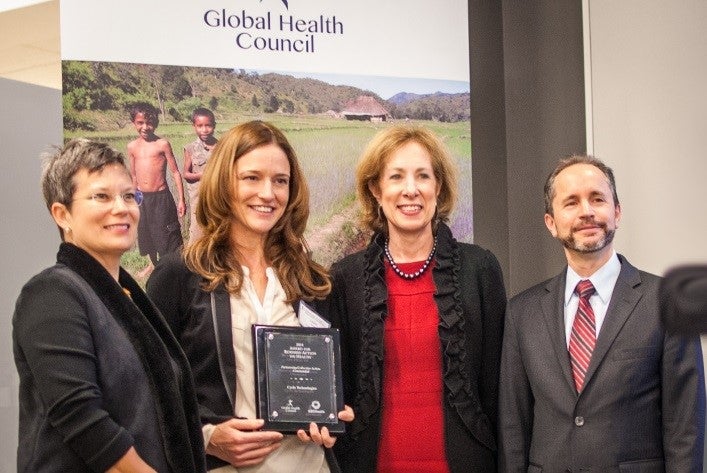5 Insights on Leading Successful Private-NonProfit Global Health Partnerships
[Originally posted on K4Health’s Blog here]
Historically, it has been a challenge for the private sector and nonprofits to successfully partner. Each side tended to distrust the other’s intentions, and the goals were often mismatched. Having worked in the global health sector leading a private social impact company for the past 13 years, I’ve seen a positive change in this dynamic in recent years.
The private sector has begun to understand and emphasize the importance of having social impact that goes beyond just how it impacts the company’s bottom line. Nonprofits have begun to see that there’s more to the private sector than profit-seeking. Beyond its potential as a funder, the private sector can be a key partner, offering skills and pathways to create programs with real impact.
Nowhere is it more important for cross-sector partnerships to succeed than in global health. With people’s lives at stake, it is critical that the best and most appropriate solutions are made available in a cost-effective, sustainable way.
Through Cycle Technologies’ work with the Institute for Reproductive Health at Georgetown University (IRH) we have learned a lot about what it takes to have a successful partnership between a private company and a nonprofit research organization. We’ve gained a few insights along the way.
Insight 1: Find partners you trust.
This might seem obvious, but the fact is that you have to truly trust each other. You have to know that regardless of what agreements might or might not say, the people involved are going to do their best to “do right”. If you don’t have this level of inherent trust, the partnership is doomed. Even with this level of trust, partnerships take a lot of work, but this confidence will help overcome and address any issues that come up.
Insight 2: Understand the individual goals of each organization in addition to the partnership goals.
Most organizations will lay out specific goals for the relationship. But it’s also critical that partners understand each other’s individual interests, goals, and motivations. If one partner is not getting what it wants or needs out of the relationship, it won’t be long before this partner becomes less invested. Or, other interests may creep in and affect an organization’s initial commitments to achieving collective goals. Communicating this can sometimes be a challenge, but if you trust each other (see insight 1), you are more likely to have an open, honest dialogue about juggling your own needs with that of the partnership.
Insight 3: Focus on HOW you will work together more than WHY you will work together.
You must have a shared vision for achieving project goals. But in order for a partnership to succeed, it’s even more important to think about how the partners will work together. Who is responsible for which activities? Be clear and specific. How will decisions get made? Involve both organizations to bring different perspectives to the table. How do we know we are on the right track? Create metrics to identify progress and discuss any gaps before they undermine the work. The answers to these questions may evolve and change, so make sure you have frequent and ongoing conversations about what’s working, what’s not, and how to improve the process.
Insight 4: Communicate about the partnership internally.
Partnerships are really about people. All too often they involve only a few people at each organization. Without a lot of internal communication, many of the people in an organization may be completely unaware of the partnership, or at the very least unaware of how it is affecting their work. In order for a partnership to be truly successful, everyone at an organization should have at least a basic understanding of the collaboration and the benefits that it brings to his or her organization. This creates buy-in, which ensures the partnership remains strong. Involving others can also generate new ideas and opportunities for growth.
Insight 5: Embrace your differences, and figure out how best to leverage them.
Among the greatest assets that a partnership brings are complementary skill sets. Private companies often bring intellectual property, manufacturing and distribution capabilities, and expertise in sustainable business practices. Nonprofit organizations often bring expertise in low- and middle-income country health systems, research and evaluation capabilities, and partnerships with policymakers and governments. The goal of any cross-sector partnership is to bring together these different skill sets to achieve more than either organization could possibly hope to achieve alone.
Partnerships are complex, but successful partnerships can make for extremely fruitful interventions and projects that save lives.
—
 Leslie Heyer is the Founder of Cycle Technologies, a socially-minded consumer product company based in Washington, DC. Since 2002 Cycle Technologies has partnered with the Institute for Reproductive Health under the Solutions for Unmet Need in Family Planning (SUN-FP) program to make available effective, easy to use, low cost family planning options to women all over the world. The SUN-FP program has particularly focused on women in low resource settings with the most unmet need for contraception. To date, these family planning options have been made available through programs in over 60 countries and an estimated 4.5 million unplanned pregnancies have been prevented.
Leslie Heyer is the Founder of Cycle Technologies, a socially-minded consumer product company based in Washington, DC. Since 2002 Cycle Technologies has partnered with the Institute for Reproductive Health under the Solutions for Unmet Need in Family Planning (SUN-FP) program to make available effective, easy to use, low cost family planning options to women all over the world. The SUN-FP program has particularly focused on women in low resource settings with the most unmet need for contraception. To date, these family planning options have been made available through programs in over 60 countries and an estimated 4.5 million unplanned pregnancies have been prevented.

Cycle Technologies and the Institute continue to work under the SUN-FP initiative to make existing contraceptive options more widely available, and to create new ones that help address unmet needs in family planning worldwide. The SUN-FP program was recently a commended finalist in the 2014 GHC-GBCHealth Global Health Awards in the Partnership category.
 Where We Work
Where We Work  Press Room
Press Room  FACT Project
FACT Project  Passages Project
Passages Project  Learning Collaborative
Learning Collaborative  Search All Resources
Search All Resources  Social Norms
Social Norms  Fertility Awareness Methods
Fertility Awareness Methods